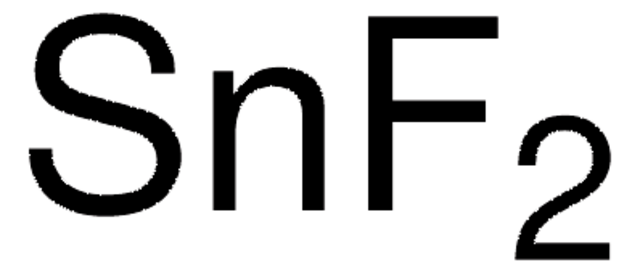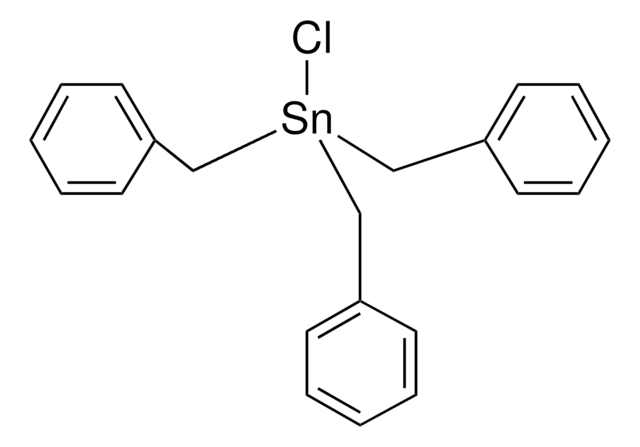265640
Tin
powder, <150 μm, 99.5% trace metals basis
Sinonimo/i:
Sn
Autenticatiper visualizzare i prezzi riservati alla tua organizzazione & contrattuali
About This Item
Formula empirica (notazione di Hill):
Sn
Numero CAS:
Peso molecolare:
118.71
Numero CE:
Numero MDL:
Codice UNSPSC:
12161600
ID PubChem:
NACRES:
NA.22
Prodotti consigliati
Livello qualitativo
Saggio
99.5% trace metals basis
Stato
powder
Impiego in reazioni chimiche
core: tin
reagent type: catalyst
Resistività
11 μΩ-cm, 20°C
Dimensione particelle
<150 μm
P. ebollizione
2270 °C (lit.)
Punto di fusione
231.9 °C (lit.)
Densità
7.310 g/mL at 25 °C (lit.)
Stringa SMILE
[Sn]
InChI
1S/Sn
ATJFFYVFTNAWJD-UHFFFAOYSA-N
Categorie correlate
Descrizione generale
Tin is an efficient catalyst for the polycondensation of lactic acid to synthesize poly(lactic acid).
Applicazioni
With HCl, reduces a variety of functional groups; stereoselective allylation of carbonyl compounds; in situ generation of tin enolates for directed aldol reactions.
Codice della classe di stoccaggio
13 - Non Combustible Solids
Classe di pericolosità dell'acqua (WGK)
WGK 3
Punto d’infiammabilità (°F)
Not applicable
Punto d’infiammabilità (°C)
Not applicable
Dispositivi di protezione individuale
dust mask type N95 (US), Eyeshields, Gloves
Scegli una delle versioni più recenti:
Possiedi già questo prodotto?
I documenti relativi ai prodotti acquistati recentemente sono disponibili nell’Archivio dei documenti.
I clienti hanno visto anche
P Olmedo et al.
Environment international, 59, 63-72 (2013-06-25)
Although fish intake has potential health benefits, the presence of metal contamination in seafood has raised public health concerns. In this study, levels of mercury, cadmium, lead, tin and arsenic have been determined in fresh, canned and frozen fish and
Lun Li et al.
Journal of the American Chemical Society, 135(4), 1213-1216 (2013-01-15)
Single-layer single-crystalline SnSe nanosheet with four-atomic thickness of ~1.0 nm and lateral size of ~300 nm is presented here by using a one-pot synthetic method. It is found that 1,10-phenanthroline plays an important role in determining the morphology of the
Rutile-type (Ti,Sn)O₂ nanorods as efficient anode materials toward its lithium storage capabilities.
Yu-Chun Chen et al.
Nanoscale, 5(6), 2254-2258 (2013-02-13)
A series of rutile-type (Ti,Sn)O2 solid solutions with nanorod architecture were successfully synthesized in this study by varying their calcination temperatures of tin-modified titanium dioxide (Sn/TiO2) nanocomposites under a nitrogen atmosphere. During the delithiation process, the (Ti,Sn)O2 nanorods obtained at
Shiyou Chen et al.
Advanced materials (Deerfield Beach, Fla.), 25(11), 1522-1539 (2013-02-13)
The kesterite-structured semiconductors Cu2ZnSnS4 and Cu2ZnSnSe4 are drawing considerable attention recently as the active layers in earth-abundant low-cost thin-film solar cells. The additional number of elements in these quaternary compounds, relative to binary and ternary semiconductors, results in increased flexibility
D B Shpakovsky et al.
Dalton transactions (Cambridge, England : 2003), 41(48), 14568-14582 (2012-10-12)
Four new organotin(IV) complexes of bis-(2,6-di-tert-butylphenol)tin(IV) dichloride [(tert-Bu-)(2)(HO-Ph)](2)SnCl(2) (1) with the heterocyclic thioamides 2-mercapto-pyrimidine (PMTH), 2-mercapto-4-methyl-pyrimidine (MPMTH), 2-mercapto-pyridine (PYTH) and 2-mercapto-benzothiazole (MBZTH), of formulae {[(tert-Bu-)(2)(HO-Ph)](2)Sn(PMT)(2)} (2), {[(tert-Bu-)(2)(HO-Ph)](2)Sn(MPMT)(2)} (3), {[(tert-Bu-)(2)(HO-Ph)](2)SnCl(PYT)} (4) and {[(tert-Bu-)(2)(HO-Ph)](2)SnCl(MBZT)} (5), have been synthesized and characterized by elemental
Articoli
Nanomaterials for Energy Storage in Lithium-ion Battery Applications
Il team dei nostri ricercatori vanta grande esperienza in tutte le aree della ricerca quali Life Science, scienza dei materiali, sintesi chimica, cromatografia, discipline analitiche, ecc..
Contatta l'Assistenza Tecnica.




